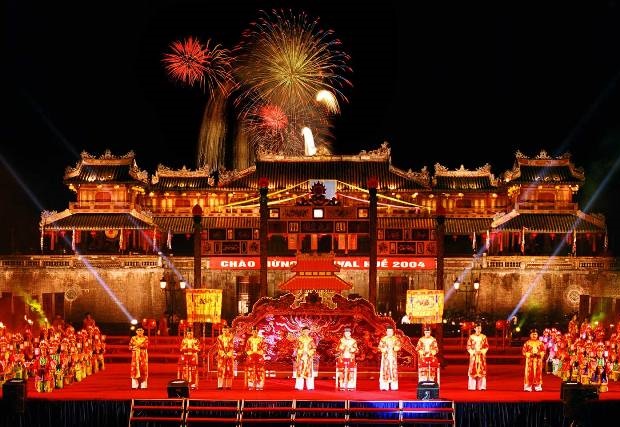Beauty of Last Imperial Capital on Hue Festival 2022

Home to Vietnam’s last imperial court, Hue is a gracious city that deserves it status as a UNESCO World Heritage Site. Our ancestors chose wisely when founding Hue in the basin of the Perfume River. Seeing the city from above, it seems that the Citadel has added to the beauty of the Perfume River. But without the river, the Citadel would not have been built. Let’s discover the beauty of the last imperial Capital on the occasion of Hue Festival.
By the source of the Perfume River at the foot of mighty Truong Son mountains, the mausoleums of Nguyen dynasty emperors rise from lush greenery. Simple yet magnificent, Gia Long’s Mausoleum is encircled by 36 mountains of various sizes. This mausoleum was originally planned to cover more than 2,800 hectares, making it one of the largest royal mausoleums in the world. Minh Mang’s Mausoleum lies at Bang Lang bifurcation where Ta Trach and Huu Trach, two branches of the Perfume River, converge It’s an architectural masterpiece thanks to its symmetry and it enchanting atmosphere. Also worth mentioning is Thieu Tri’s Mausoleum, which is embraced by lakes, pine forests, paddy fields and villages. On the far side of Vong Canh (Sightseeing Hill) lie the clustered mausoleums of Tu Duc, Dong Khanh and Kien Thai Vuong, resembling picturesque gardens. By the river, visitors will find other noteworthy old sites, including Hon Chen Temple, the Temple of Literature and Thien Mu Pagoda.
From the Bang Lang bifurcation to the sea, the Perfume River meanders around villages, gardens, temples, imposing palaces and a young, vital city. The Hue Citadel is surrounded by the Perfume River’s four main branches in all four directions and designed to form a straight royal axis from the heart of the Imperial Palace to the Flag Staff, Phu Van Pavilion, the Welcoming Pavilion and Ngu Binh Mount to the south. After more than two centuries of turbulence, the ancient fortresses, palaces and imposing mausoleums remain virtually intact.
In modern streets and residential areas, we can still find old pavilions, houses and garden houses once owned by aristocrats, royals and wealthy clans. These serve as miniature museums and silent guardians of the traditions, customs and lifestyles of Hue people.
An aerial view of Hue sheds light on the beauty and natural harmony of this former citadel. Mausoleums and sacrificial sites to the west bordered by undulating mountains and lush jungles are connected to the imperial palaces to the east where the plains, rivers and canals merge and release their vitality. Hue is the only city in Vietnam to boast such yin-yang harmony in its urban planning, even sparing space for the realm of ghosts, which, legend has it, is connected to our world via the Perfume River.
Seeing Hue from above enhances our knowledge of its founders sea-driven vision. It’s just 10km from the Citadel to Thuan An Estuary. Tam Giang Lagoon spans from one to four km across and stretches around 60km long, like a blue sash screening the vast East Sea. This is where many rivers temporarily stop and fuse their energies before flowing in the sea. The estuaries of Thuan An and n are gateways that connect the capital of Phu Xuan- Hue to the sea. They were closely linked with Hoi An Port and Danang Harbor, and served as witnesses to many significant events throughout our history. When Hue was made the nation’s capital, acclaimed its sovereignty of the two archipelagoes of Truong Sa (Spratly Islands) and Hoang Sa (Paracel Islands) and countless offshore islands from the of Gulf of Tonkin to the Gulf of Thailand.
The Hue’s Beauty is found nowhere else…Let’s enjoy the Hue Festival.